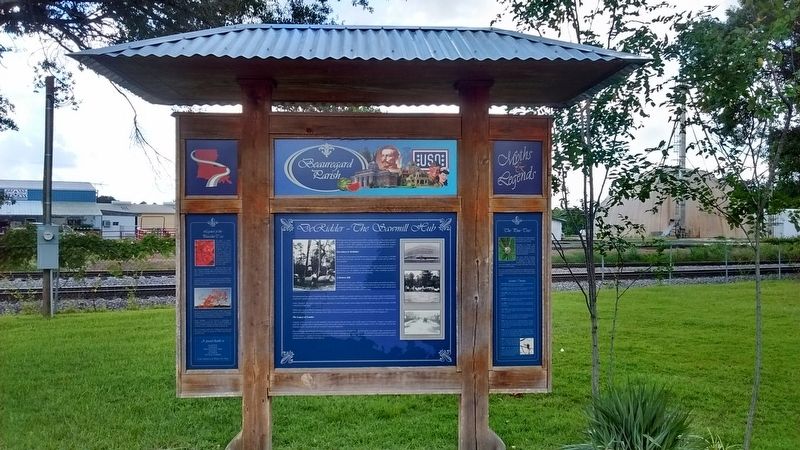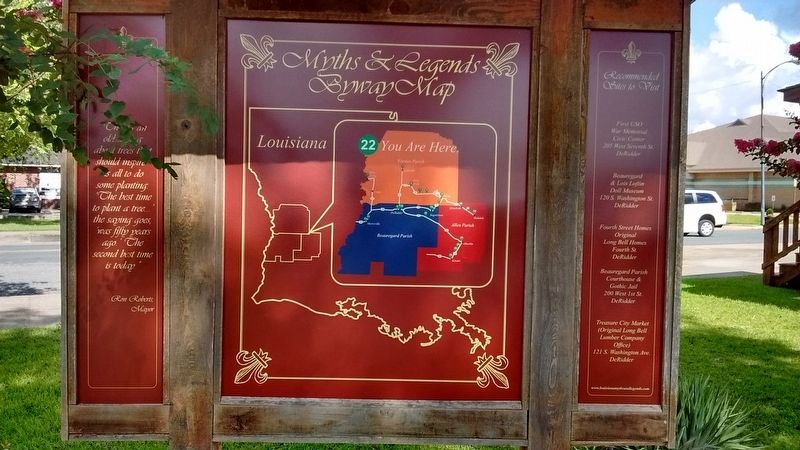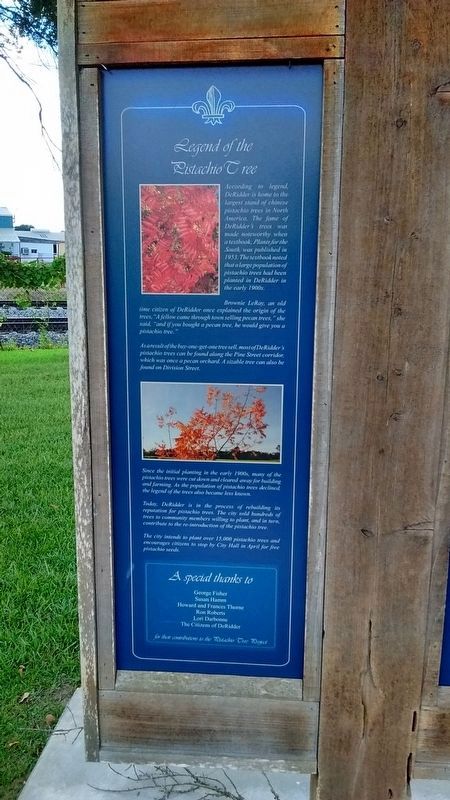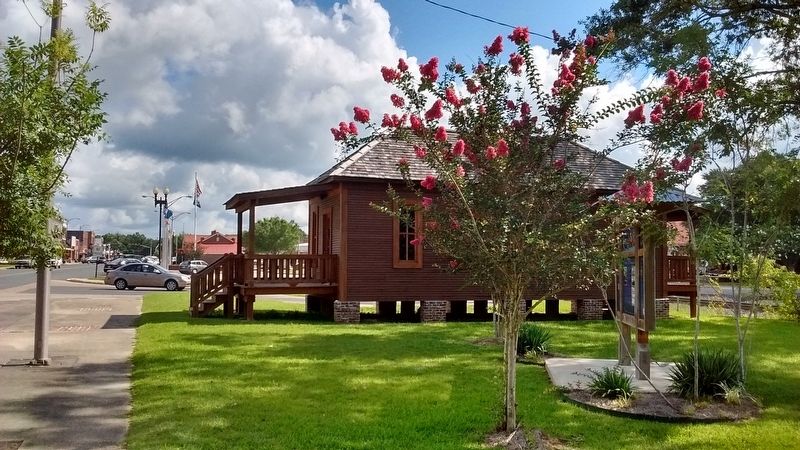DeRidder in Beauregard Parish, Louisiana — The American South (West South Central)
DeRidder - The Sawmill Hub
Myths & Legends - Beauregard Parish
Climbing roses and vine covered trellises, along with flowering plants adorned the yards of the 125 tenant houses that were built by the Hudson Lumber Com0any in 1903. The subsidiary sawmill was built by Long Bell Lumber Company in DeRidder which eventually became the hub for area saw mills.
Operations in DeRidder
By 1904, the mill produced 34,000,000 feet of lumber or an average of 150,000 feet for each work day. Already it was shipping lumber at a rate of 3,000 box cars annually.
In 1905 the plant employed 200 mill hands and loggers and owned 16 miles of tram railroad into the forest consisting of three, pine-knot burning locomotives and 60 log cars. In addition to the plant office, other buildings included a dispensary, a union school and church building.
A Modern Mill
A battery of boilers and a 400-hp Corliss steam engine operated everything in the sawmill. In addition to a single cutting band saw, the sawmill cutting tools consisted of a gang saw, edgers, trimmer saws, a cutoff saw, and a double band saw, cutting on each direction of the carriage.
The planning mill operated 13 machines including two planer-moulders, six planer-matchers, a band resaw, ripsaw, edge, a picket header, cutoff saws, and flooring machines. At any one time there were 9,000,000 feet of lumber on the yard, either drying, stored, or being loaded.
At the “log front” the loggers used 50 horses and mules, 8-wheel log wagons, and a Ledgerwood skidder-loader that could handle 140,000 scaled feet of logs daily.
Timber men, such as Willis Grantham, blazed their way in to the forest and set up tents where the logging men would stay. There were no improved roads in those days and many times Willis, who drove an automobile, would ford creeks to establish the logging site.
The Legacy of Lumber
A legacy of the saw-mill era is the beautiful curly pine timber that decorates a few of the homes on Fourth St. Unique to our gulf coast area, the curly pine trim is a deformation of the heart rings of the pine tree that are curled in irregular circles. The curly pine was cut into framing, panels, and posts and was saved for Long Bell employees.
One such home with distinctly decorative woodwork was purchased by Charles Sills, Superintendent of Longbell. Other recipients of the curly pine in the construction of their homes were the General Manager and company Doctor. The beautiful curly pine adornments found on these homes is significant because curly pine was cut to extinction by the 1920s. The restored homes on Fourth Street now stand as monuments to the Deridder saw-mill era.
(left panel)
Legend of the Pistachio Tree
According to legend, DeRidder is home to the largest stand of Chinese pistachio trees in North America. The fame of DeRidder’s trees was made noteworthy when a textbook, Plants for the South, was published in 1953. The textbook noted that a large population of pistachio trees had been planted in DeRidder in the early 1900s.
Brownie LeRay, an old time citizen of DeRidder once explained the origin of the teres, “A fellow came through town selling pecan trees,” she said, “and if you bought a pecan tree, he would give you a pistachio tree.”
As a result of the buy-one-get-one tree sell, most of DeRidder’s pistachio trees can be found along the Pine Street corridor, which was once a pecan orchard. A sizable tree can also be found on Division Street.
Since the initial planting in the early 1900s, many of the pistachio trees were cut down and cleared away for building and farming. As the population of pistachio trees declined, the legend of the trees also became less known.
Today, DeRidder is in the process of rebuilding its reputation for pistachio trees. The city sold hundreds of tress to community members willing to plant, and in turn, contribute to the re-introduction of the pistachio tree.
The city intends to plant over 15,000 pistachio trees and encourages citizens to stop by City Hall in April for free pistachio seeds.
(right panel)
The Pine Tree
In 1900 the soils of Beauregard Parish held one of the premier pine forests in the world.
According to legend, the largest pine tree in the world was located in DeRidder. These trees first sprouted at about the time Christopher Columbus discovered America.
One early visitor, traveling by train from lake Charles to DeRidder at high noon, remarked that it could easily have been midnight. The thick canopy of the huge trees could not be pierced by sunlight.
Over the next quarter of a century, the majestic pines were harvested. Much of the lumber used to build both Chicago and New York City came from the pine trees of Beauregard Parish.
(sidebar)
Lumber Timeline
1492-1700s: Southern yellow pine trees sprout up from Louisiana’s fertile soil and grow undisturbed for centuries.
Late 1700s: Settlers push westward and use the pine trees to build small log homes. The forest grows in its natural state.
Early 1800s: Yellow pine trees are cleared away for roads and farmland. Farmers use dynamite to remove stumps from their property.
Mid 1800s: Small sawmills are built, but the Southern yellow pines avoid the mass cuttings of the logging years.
Late 1800s: Turpentine camps spring up across rural Louisiana. Turpentiners use the resin from the tree to create turpentine and other products.
Early 1900s: Industrial logging firms push their way into the pine forests and establish logging camps and large-scale logging and milling operations.
1925: Over 25 years, the loggers cut down thousands of acres of pine forests. Only a smattering of pine trees remained. Reforestation efforts were implemented, and new trees were planted.
1930s: With no more trees to cut, logging companies sold their deforested properties for a low price. Depression-era farmers purchased the cut-over land for $2.00 an acre. Farmers struggled to remove the stumps from their property, which often made the land unprofitable.
1940s: The Crosby naval Stores Company opened a chemical plant in DeRidder. They began making turpentine from the tree stumps. Crosby would pay 20 cents per ton for stumps. Work crews, mostly independents, would dynamite the stumps from the ground, load them on trucks, and haul them to the mill.
1960s: Boise Southern, an affiliate of Boise Cascade, constructed a paper mill in DeRidder. The reforested trees, much smaller than the original timber, were ideal for papermaking.
Today: Because of reforestation efforts, pine trees in Beauregard Parish are growing faster than they can be harvested. For the economy of Beauregard Parish, pine trees are both the past and the future.
Erected by State of Louisiana Myths & Legends Trails and Byways. (Marker Number 22.)
Topics and series. This historical marker is listed in these topic lists: Horticulture & Forestry • Industry & Commerce. In addition, it is included in the Louisiana Myths & Legends Byway series list. A significant historical year for this entry is 1903.
Location. 30° 50.664′ N, 93° 17.176′ W. Marker is in DeRidder, Louisiana, in Beauregard Parish. Marker is at the intersection of South Washington Street and West 3rd Street, on the right when traveling north on South Washington Street. Touch for map. Marker is in this post office area: Deridder LA 70634, United States of America. Touch for directions.
Other nearby markers. At least 8 other markers are within 11 miles of this marker, measured as the crow flies. Sam Houston Jones (about 600 feet away, measured in a direct line); Beauregard Parish Gothic Jail (approx. 0.2 miles away); Shootout At Grabow (approx. 2.8 miles away); World War II DeRidder Army Air Base Memorial (approx. 3 miles away); Grabow Riot (approx. 3.7 miles away); Rosepine, Louisiana (approx. 5.2 miles away); Shady Grove School/Community Building (approx. 7.2 miles away); Wolf Rock Cave (approx. 10.4 miles away). Touch for a list and map of all markers in DeRidder.
Also see . . . DeRidder, Louisiana. (Submitted on November 2, 2017, by Tom Bosse of Jefferson City, Tennessee.)
Credits. This page was last revised on December 31, 2021. It was originally submitted on November 2, 2017, by Tom Bosse of Jefferson City, Tennessee. This page has been viewed 807 times since then and 65 times this year. Photos: 1, 2. submitted on November 2, 2017, by Tom Bosse of Jefferson City, Tennessee. 3, 4, 5. submitted on February 12, 2018, by Tom Bosse of Jefferson City, Tennessee. 6. submitted on November 2, 2017, by Tom Bosse of Jefferson City, Tennessee. • Bernard Fisher was the editor who published this page.





